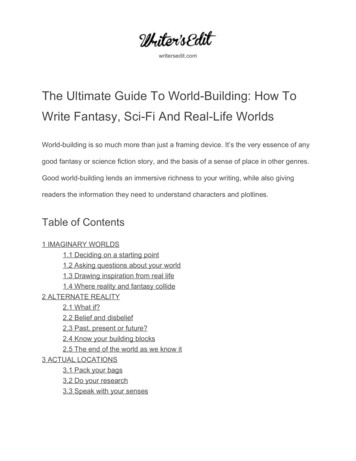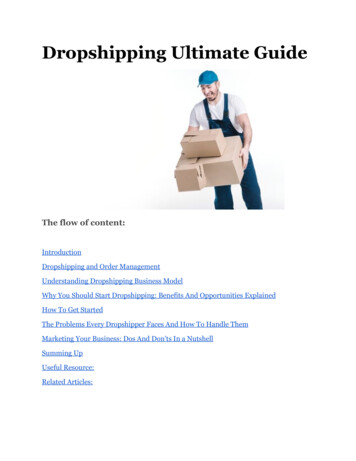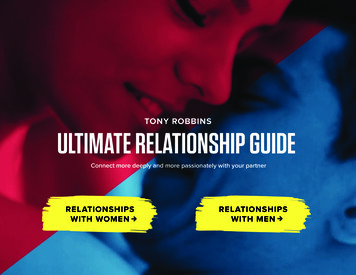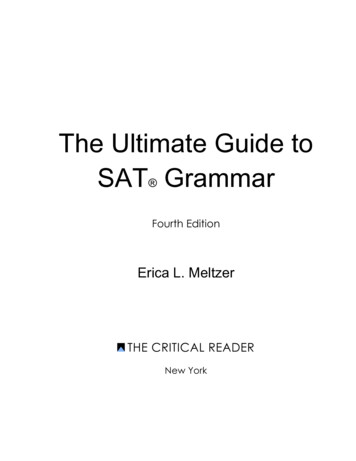
Transcription
writersedit.comThe Ultimate Guide To World Building: How ToWrite Fantasy, Sci Fi And Real Life WorldsWorld building is so much more than just a framing device. It’s the very essence of anygood fantasy or science fiction story, and the basis of a sense of place in other genres.Good world building lends an immersive richness to your writing, while also givingreaders the information they need to understand characters and plotlines.Table of Contents1 IMAGINARY WORLDS1.1 Deciding on a starting point1.2 Asking questions about your world1.3 Drawing inspiration from real life1.4 Where reality and fantasy collide2 ALTERNATE REALITY2.1 What if?2.2 Belief and disbelief2.3 Past, present or future?2.4 Know your building blocks2.5 The end of the world as we know it3 ACTUAL LOCATIONS3.1 Pack your bags3.2 Do your research3.3 Speak with your senses
So, how exactly should writers go about building worlds in their fiction? To find out, we’llbreak down the concept of world building into three main categories: Imaginary worlds – the construction of entirely fictional universes, foundprimarily in fantasy genres. Alternate reality – re imaginings of the details of our existing world; popular withwriters of science fiction. Actual locations – the invocation of a real place in the world, utilised in novelswith no elements of the fantastic.Let’s begin by entering the wondrous realm of fantasy fiction.IMAGINARY WORLDSCreating an imaginary world is one of the most complex types of world building. It’smost often utilised in fantasy and science fiction, where a writer conjures up fromscratch every detail of a world: geography, history, language, lore, characters, socialcustoms, politics, religion Understandably, the thought of creating all these elements to form an entire fictionalworld can be very daunting – and deciding where to start can seem almost impossible!For inspiration, we recommend turning to some of the great world builders of our time tosee how they’ve built up whole universes from nothing.1
Deciding on a starting pointJ. R. R. Tolkien, author of Lord of the Rings , The Hobbit and countless other classicworks, began the development of Middle earth in an unusual way: by first creating anentire fictional language to be spoken by his characters. A professional philologist andtalented linguist, Tolkien developed the Elvish language of Quenya, using it as a basefor expanding his imaginary world into the vast, detailed, lore rich Middle earth we knowtoday.Of course, not all writers will be capable of (or interested in) creating a functional,fictional language – but budding world builders can still follow Tolkien’s lead in order toget started. By pinpointing one aspect of your imaginary world that you’re mostinterested in or most apt at developing, you’ve got yourself a great starting point. Workhard on this element first, and then concentrate on building up and fleshing out fromthere. You’ll find that the pieces of your world fall much more easily into place once youhave a solid foundation from which to expand.Asking questions about your worldAfter you’ve got the ball rolling by establishing a starting point, you’ll need to beginworking out the details that make up a convincing, consistent imaginary world. A greatway to start doing this is to ask (and answer) a set of questions pertaining to thedifferent aspects of your world.2
Approach this exercise as if you were describing your home country to someone whoknows nothing about it – or, on a larger scale, as if you were introducing Earth tosomeone from an alien race. How would you explain: What it looks and feels like – its landscapes, its climate? Its people – their appearance, customs, ethics and values? The dominant forces that shape change and development?If you’re feeling overwhelmed by all the potential details you need to cover, it’sadvisable to start by creating a list of fundamental questions you need to answer aboutyour world. Many online resources, such as this list from the Science Fiction andFantasy Writers of America website , contain suggested questions about everything fromsocial organisation and government to the rules of magic and technology. (The latter ofthese is particularly important to keep in mind. Even though your world may be anentirely imaginary one filled with magic or made up technology, it must still be governedconsistently and carefully by the internal logic and laws you set up for it. Its fantasticalnature cannot be used as an excuse for lapses in continuity.)After devising your list, you may feel even more overwhelmed now you have such anexpansive range of questions to answer! If this is the case, take a step back and makesure that all the questions you’ve listed really need to be covered. It’s likely that somequestions may not apply to or directly affect your characters and narrative, so decidewhich aspects are most crucial to the stories you want to tell within your world, andfocus on answering the most relevant questions.3
While you’re answering these world building questions largely for the benefit of yourreaders, it’s imperative to keep in mind the age old advice about showing, not telling .You don’t want readers to feel like they’re simply being spoon fed a bunch of facts,details and history. The most successful storytelling comes from a subtle, nuancedapproach to building your world through narrative detail, description and development.Map of the realms of Middle earth, as imagined by Tolkien.Drawing inspiration from real lifeEven though imagining an entirely new world is one of the most creative processes awriter can undertake, it’s almost impossible to create something entirely from nothing.4
Naturally – even if only subconsciously – you will adapt and incorporate some real worldelements into your imaginary setting and story, using them as a base of inspiration.A well known fantasy epic with strong undertones of historical influence is George R. R.Martin’s series, A Song of Ice and Fire. Martin openly acknowledges the fact that manyelements of ASOIAF are inspired by real historical events and locations: the Wars of theRoses , the Glencoe Massacre and Hadrian’s Wall , to name just a few.If you feel your world is lacking in depth or credibility, perhaps take a leaf from Mr.Martin’s (extremely long) book and delve into some real world history for inspiration.You may be able to flesh out your world by moulding, adapting or drawing parallels withreal life locations, landmarks, pivotal events, or even historical personalities.The sprawling city of Meereen from George R. R. Martin's 'A Song of Ice and Fire'.5
Where reality and fantasy collideAn interesting way to provide contrast or conflict within your story is by developing yourfictional world alongside, or within, an established location – for example, right here onEarth. Perhaps the most famous example of this reality/fantasy cross over is J. K.Rowling’s Harry Potter series, which involves an entirely made up world of magic that’shidden away on modern day Earth. Harry himself, as the main character from whosepoint of view the story is presented, is as much a stranger to this world as readers are inthe beginning. We’re introduced firsthand to every person, place, detail and experienceright alongside Harry; as he journeys into this magical new world and has his questionsanswered, so, too, do we as readers.Harry enters Diagon Alley to explore his magical new world.6
As well as adding depth and relatability to your story, such a setting also posesquestions about the concept of an alternate reality . Let’s now look at this concept inmore detail.ALTERNATE REALITYSimilar to the creation of an imaginary world, but slightly less demanding due to theexisting base you have to work with, the construction of an alternate reality is a type ofworld building often found in dystopian, speculative and science fiction. By creating analternate reality, you are developing an alternative version of our own Earth, imagininghow things could be different and posing questions about what these differences wouldmean for humanity. Authors often use this style of writing to express their thoughtsabout the flaws of humanity and today’s world, exploring the consequences these flawsmay have to potential to produce.What if?As a writer imagining an alternate reality, the most important question you can ask is‘What if?’ This is the base level query on which your story’s entire premise should befounded, and upon which you will build the individual elements of your world. Forexample: What if a particular, important historical event had never happened? What if our planet and its inhabitants had evolved differently? What if a fundamental aspect of life as we know it was to change suddenly?7
What if we invented new technology that could accomplish wonderful/terriblethings? What if we could visit or communicate with other life forms (or vice versa)?These are the type of questions you should be asking as you develop the differencesbetween your world and the real world. They are the essence of the changes,challenges and consequences you should examine through your alternate setting, itscharacters and their narrative.Advanced technology features prominently in Suzanne Collins' 'Hunger Games' series.Belief and disbeliefA key difference between creating an alternate reality and creating an imaginary worldis the suspension of disbelief you can expect from your readers. The imaginary worldsof fantasy and science fiction we examined above – Westeros and Essos, the kingdomsof Middle earth – imagine an entirely new world, quite unrelated to our own. Due to this8
complete removal from reality, readers automatically enter with a higher level oftolerance for things that may otherwise have jarred the story’s logic or lifted them out ofthe moment. Readers would never think to question, for example, the fact that a singlemagic ring has the power to rule the world; they’re also less likely to query the fact thata teenage girl is slowly conquering a kingdom when there are dragons involved in theequation!In alternate reality fiction, however, you may have to work a little harder to draw readersdeep into your world – and keep them there. The slightly familiar settings, warpedrealities and semi relatable human scenarios presented in this type of storytelling willheighten readers’ senses of what’s believable and what’s not. Therefore, you’ll need toconvince them that everything happening in your story is a realistic possibility for theEarth on which it is based. Let’s look at some of the best ways to achieve this.A cityscape from an alternate reality. Image credit: Ashish Dani.9
Past, present or future?One of the best ways to begin establishing your alternate reality is by clarifying the timeperiod in which you want it to be set. When will your story take place in relation to thereal world? Is it:Each of these approaches has its own advantages and benefits, and each lends itselfwell to different purposes. You’ll need to decide which of these settings best serves theparticular story you want to tell.If you choose to rewrite the past , you are employing the gift of hindsight to imagine whatcould have been; think of it as alternate reality historical fiction, if you will. A well knownexample is sci fi author Philip K. Dick’s The Man in the High Castle , which explores ourworld ‘as it might have been’ if the outcome of World War II had been different.Likewise, the majority of volumes in Jasper Fforde’s Thursday Next series take place inan alternative 1985, where England and Russia have been fighting the Crimean War forover a century. Not restricted to reimaginings of definitive wartime conflicts, however,this method of storytelling is also a popular vehicle for stories about time travel; H. G.Wells’ pivotal novel The Time Machine and more recent books such as Stephen King’s11/22/63 are great examples of time travel tropes used effectively to explore alternaterealities.Stories set in the present, on the other hand, have an element of immediacy and can bemore easily related to by the reader. This type of story can often be considered similar10
tothose that rewrite the past, as it often imagines drastically altered historical eventspreceding its own setting. However, the main difference is that present day stories focussolely on portraying of an alternate version of today’s world, rather than rewriting thehistory that has come before. As we mentioned above, the Harry Potter series, whileprimarily a fantasy, might also be considered an alternate reality; it takes place onEarth, in the modern day U.K., but is largely set within a magical world that lies hiddenwithin our own. Jonathan Swift’s Gulliver’s Travels and C. S. Lewis’ Chronicles ofNarnia employ similar settings of an unknown world within a world.Finally, imagining the future can serve as a warning or projection of what might be tocome if the present day world does not change its ways. George Orwell’s seminal work,1984 , is a classic example of this; published in 1949, it leaps almost 40 years into thefuture to make bold extrapolations about the potential dangers of politics andtechnology. Similarly, Suzanne Collins’ wildly popular Hunger Games trilogy, as well asAldous Huxley’s esteemed 1931 novel Brave New World , both pose questions about thedemoralisation of the human race, depicting the type of scenario that could be in storefor our future.11
Know your building blocksIn order to portray a compelling alternate version of the world, you must first bewell versed in the facts of the real version. Whether you’re setting your alternate realityin a real world location or reimagining a history event, learn all you can about its realcounterpart and incorporate your knowledge into your new interpretation.As mentioned above, Orwell’s 1984 is perhaps the most well known example of a novelexploring an alternate reality. On the surface, it’s a story about an alien sounding,utilitarian nation that’s as far removed as possible from the Earth we knew in 1984.However, when we look a little deeper (as most of us were forced to do as high schoolEnglish students), the meaningful real world allegories Orwell is drawing – Soviet Unionpolitics, life in wartime Britain – become all too clear. It’s obvious he really knew his stuffbefore bringing to life his alternate futuristic vision.12
George Orwell presents his own futuristic vision of society in '1984'.The end of the world as we know itDystopian and post apocalyptic fiction has seen a meteoric rise in recent years,especially in the young adult sub genre. The Hunger Games trilogy, perhaps the mostpopular of the bunch, has spawned a plethora of YA novels set in reimagined versionsof Earth, and it’s easy to see why. Imagining a global scale apocalyptic event gives youthe freedom to predict how humanity might rebuild itself after such a disaster – a meatysubject to tackle.A key decision to be made when writing in this genre is how you will treat theapocalyptic event itself. The most common choice is to set the narrative after the eventand describe its consequences (hence ‘post apocalyptic fiction’ becoming a well knowngenre in itself).Series such as the Hunger Games and Maze Runner trilogies, as well as standalonenovels like Cormac McCarthy’s The Road and Richard Matheson’s much adapted I AmLegend , choose the post apocalyptic path. I Am Legend and the Maze Runner booksallude to a deadly global pandemic, while The Hunger Games and The Road bothchoose not to disclose the manner of the cataclysm that preceded their events.Ultimately, you’ll need to decide if clarifying the apocalyptic event is necessary byconsidering the ways it could benefit or detract from your story.13
Despite the prevalence of the post apocalyptic approach, remember that you also havethe option to portray the actual details of the global catastrophe as it happens, as wellasthe series of events leading up to it. If you choose this method of storytelling, you maywish to consult some novels that handle it particularly well, including Lucifer’s Hammerby Jerry Pournelle and Larry Niven, The Stand by Stephen King and Oryx and Crake byMargaret Atwood.Suzanne Collins' 'Hunger Games' trilogy takes place in a dystopian society.14
Now, if you’re not a writer of fantasy or science fiction, by this stage you’re probablywondering whether there’s any point in learning about world building. Well, we’re hereto assure you that there is – so read on!ACTUAL LOCATIONSIn genres other than science fiction and fantasy, the practice of world building is morecommonly known as creating a sense of place . Place has an important role in everystory, and is often used to great effect in literary fiction. In novels with an especiallystrong sense of place, the setting virtually becomes a character in itself; it embodies,reflects, supports and enhances the narrative at every turn. So how can you build anddevelop a deep, engrossing and original portrait of an existing location?Pack your bagsThe first piece of advice for anyone wishing to infuse their work with a sense of place isalso the most obvious: go to that place ! Whenever possible, spending a good amount oftime ‘on location’ wherever you’re setting your story is the best thing you can do as awriter. Bonus points if you’re writing about the place in which you’ve grown up or spentthe majority of your life; if you know the place inside out, it’s going to be much easier topaint a convincing and engaging picture for your readers.15
The Brontë sisters are a fantastic example of writers drawing on personal influencesand surroundings to create a strong sense of place. Emily’s only novel, WutheringHeights, interweaves a bleak landscape of English moors so powerfully into hernarrative that it practically becomes a definitive character in itself. Charlotte’sbest known work, Jane Eyre , creates a compelling portrait of life at a 19th centuryEnglish boarding school; along with Anne’s first novel, Agnes Grey, Jane Eyre alsoexplores life as a governess ina noble family (and as a woman in Victorian England). However, the Brontës are by nomeans the be all and end all of creating a sense of place – pick up any good novel setin a specific location and you’re sure to pick up some tips.16
The wild English moors become a character in themselves throughout much of theBrontë sisters' work.Do your researchSometimes – for example, in the case of a novel set 50 years in the past – it’s notpossible to have an authentic experience of the place you’re writing about. In this case,you will really need to do your research – and we don’t just mean a bit of Googling,because unfortunately, that won’t quite cut it! You’ll need to delve deeply into the historyof the place in any way you can: by watching documentaries, visiting museums, readingbooks and other literature from the time period – seek out anything you can get yourhands on and start absorbing it all. If you can, we also strongly recommend speaking topeople who were in that place at the right time; there’s no better source than someonewho can tell you all about it from firsthand experience.Historical fiction books are a good resource for those wishing to write immersive,authentic fiction set in past time periods and real locations. An expansive genre,historical fiction contains a wealth of titles from which to gain inspiration and examples,but a good starting place might be exploring the work of: Charles Dickens – A Tale of Two Cities conjures up particularly vivid images ofLondon and Paris during the French Revolution; Chinua Achebe – a Nigerian author whose African trilogy, especially Things FallApart , paints a striking portrait of post colonial Africa; Philippa Gregory – author of The Other Boleyn Girl , who specialises in Britishhistorical fiction that mostly examines the stories of the aristocracy.17
Other great titles to investigate include Markus Zusak’s The Book Thief , which takesplace in wartime Germany, and Arthur Golden’s Memoirs of a Geisha , set intwentieth century Japan.Arthur Golden transports us to twentieth century Japan in 'Memoirs of a Geisha'.Speak with your senses18
Building and developing a sense of place is a great excuse to flex your descriptivemuscles. But don’t just rely on describing what you see – talk about the sounds, thesmells, the feel of your chosen place; the atmosphere and the things that contribute toit; and, perhaps most importantly, the effect the place has on your characters. (On thatnote, it pays to remember not to get too bogged down in description at the expense ofplot and character development. Keep in mind that your invocation of place is ultimatelyto serve the characters and story within it.)What sort of world will you build in your fiction? Image credit: Mikhail Pavstyuk viaStockSnap Creative Commons.***19
After all that, you’re probably feeling a little overwhelmed by the amount of effort it takesto build a whole world with words – whether that world is fictional, real or somewhere inbetween. Our suggestion? Take a well earned break, make a cup of tea, and set asideyour world for now. Tomorrow it will still be there waiting for you, and armed with yournew knowledge, you’ll be ready to build it from the ground up.About The AuthorClaire BradshawClaire is a freelance writer and editor from Newcastle, NSW. She holds a B. A. inEnglish and Writing and a Graduate Certificate of Editing and Publishing. A lover ofbooks, blogs, magazines, and everything in between, you’ll either find her reading,working on an editorial project, or drinking endless cups of tea while writing things of herown. Check out more helpful tips and advice from Claire on WritersEdit.com20
You may be able to flesh out your world by moulding, adapting or drawing parallels with real life locations, landmarks, pivotal events, or even historical personalities. The sprawling city of Meereen from George R.











